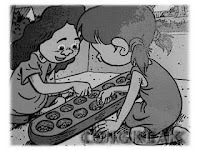Congklak are believed to have originated rather than Africa or the Arab world, depending on which theory you believe. However, the oldest evidence found by searching ancient dig funded by the National Geographic Association met limestone pieces that have two burrows selari bertarikh since 5000 to 7000 BC in present-day Jordan.
From the Middle East, the game spread to Africa. Congklak spread to Asia through Arab traders. In Southeast Asia, congklak may develop from Melaka perceived that this country is the center of trade in times of old. The name "cavalier" believed to have originated from the Malay word "conglak" which intends mental assumption. Besides Malay, Indian and Peranakan descent Melaka Baba Snippy also interested in the game.
Childhood in the Caribbean islands also play congklak. Congklak believed to get there via the slave trade. There, supercilious recognized as warri or Awari. In Indonesia, congklak congklak identified by name, in the Philippines, sungka. In ancient times, the palace group play congklak using fancy carved congklak boards, while among the common people, he just played with a probe hole in the ground. On this day, congklak played all over the world. Congklak so popular and in demand so that enthusiasts-enthusiasts created various web pages on the internet. In these web pages disenaraikan various edicts about congkkak in cultures and nations around the world. There are also games congklak in talian.
Principle Games
Congkkak game involving counting. Those who accumulate excess cekap mencongak have eyes and so win the game. In congklak game, there are two ingredients that congklak boards and pieces congklak. Congklak plank canoe-shaped and should be done rather than different types of wood and there is a line of five or seven holes recognized as the 'village' and in both there is a hole hujungnya mothers identified as 'home'. Long boards congklak seven holes are usually about 80 cm and 18 cm lebanya.
Two players required and domiciled mengadap each other. To launch the game, sap or Guli seeds in each village will be filled with the same lot and the house is left empty. In this game, players will memulakannya at once. They will take the fruit supercilious and inserted one by one into each piece cocky 'village' heading to their respective homes at the direction of rotation, so one of the stops in an empty hole and thought to be dead. 'House' is located in the pit of one's own left hujung players. A player who will continue to run again so he stopped at an empty hole. And after that each player will take turns running to his death. Each player will continue to run out of fruit supercilious game, and players will fill the holes with pieces contained in the mother hole. Players are not enough fruit will be closed the hole, and the player who wins the previous turn will lead off the game. This will be repeated so that one player is not enough fruit to fill a hole though and is considered lost, or if both players are bored. Had the player has made a revolution, namely melepasi mother hole and back into the hole next to the player, he may take conflicting pieces next hole if he had died beside his own. Is recognized as a "shoot".
Gaming Regulation
Here are the game rules supercilious most common:
Two players sit across the board facing congklak, commenced with both players simultaneously reach the fruit in each village and insert pieces one by one in the pit village with a movement from right to left up to the house and the village opponent.
Movement continued until the last fruit on hand included in the empty villages in the region itself or the opponent and the player shall stop, if only fruit that falls or dies in the village itself. The player should shoot the opponent setentang village with village namely scoop all the fruit (if any) in the village, only after making a centrifuge.
Opponents took his turn to continue the game until the death. Had fruit last fall in his own house, the player must continue the game by taking a lot of pieces that are still ubiquitous village itself. Had fruit last fall in an empty village the other side, then the game is dead in situ sake only and the opponent should launch the game on until death.
If it were not there any fruit in the village even though the player's turn to be on his side, then turn to move the pieces will be moved to the other side.
After finishing the first rotation, each player filled with fruit cavalier original village and if the village is not enough fruit, it is considered 'burnt'. The village should not be filled when playing on the second rotation, third and so on until the opposition conceded defeat.
At the end of the game, fruits congklak thought of their homes. The winner is who has the most congklak fruit. Had the same amount of fruit congklak lot, then the player with the highest number of villages burnt thought lost.

No comments:
Post a Comment